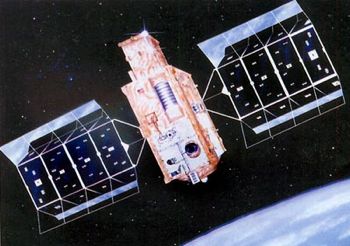
Home - Search - Browse - Alphabetic Index: 0- 1- 2- 3- 4- 5- 6- 7- 8- 9
A- B- C- D- E- F- G- H- I- J- K- L- M- N- O- P- Q- R- S- T- U- V- W- X- Y- Z
STEX
 STEX Credit: Manufacturer Image |
Status: Operational 1998. First Launch: 1998-10-03. Last Launch: 1998-10-03. Number: 1 .
These included:
- Hall Effect electric thrusters derived from Russian technology
- Experimental solar arrays and batteries
- ATEX advanced tether experiment, a follow-on to the earlier TIPS satellite. This comprised two end masses connected by a 6 kilometer polyethylene tether. The upper end mass was to be deployed first, while the lower end mass remained attached to STEX. After a series of dynamics experiments in this configuration, the lower end mass was to be separated from STEX and the ATEX became a free-flying pair subsatellite. In the event, the ATEX was jettisoned from STEX after the tether had only deployed 21 m.
NASA NSSDC Master Catalog Description
The STEX (Space Technology Experiments) satellite carried 29 new technologies intended to result in lower cost and higher performance spacecraft for future missions. Among the technologies were Russian-derived Xenon Hall-effect electric thrusters capable of delivering 40 mN of thrust, a 51 Gbit solid-state data recorder, and high-density NiH batteries designed to last longer and provide more energy with less weight. ATEx (Advanced Tether Experiment), a 6 km tether with TiPS heritage, was to be deployed as a separate sub-satellite. Frangibolts were used on the mission for shockless deployment of the spacecraft and tether. Experimental solar panels with high-efficiency solar cells were also carried. The planned lifetime of STEX was two years.
The spacecraft was comprised of a body shell and two tracking solar panels. A blowdown liquid propulsion system was carried. The spacecraft was three-axis stablized. A lightweight precision star tracker was used to determine satellite pointing.
On January 16, 1999, ATEx was deployed, but failed. It was deployed but its two masses separated only by 22 m. It is now tracked as a separate object (USA 141, 1998-055C).
More at: STEX.
Family: Medium earth orbit, Technology, Tether technology satellite. Country: USA. Launch Vehicles: Taurus, ARPA Taurus. Launch Sites: Vandenberg, Vandenberg 576E. Agency: NRO, Martin. Bibliography: 2, 279, 6948, 13225.
1998 October 3 - . 10:04 GMT - . Launch Site: Vandenberg. Launch Complex: Vandenberg 576E. LV Family: Taurus. Launch Vehicle: ARPA Taurus.
- STEX - .
Payload: STEX. Nation: USA.
Agency: NRO.
Manufacturer: NRL.
Class: Technology.
Type: Ion engine technology satellite. Spacecraft: STEX.
USAF Sat Cat: 25489 . COSPAR: 1998-055A. Apogee: 759 km (472 mi). Perigee: 744 km (462 mi). Inclination: 84.99 deg. Period: 99.77 min.
Tested TAL-D55 plasma engine and was to be part of the NRO's ATex tether experiment. The ATeX lower end mass was meant to remain attached to the STEX parent spacecraft, but with only 21 m of tether deployed, it appeared the tether was so far off vertical that automatic safety systems jettisoned the base to protect the remainder of the STEX satellite. Thus, the upper and lower ATeX end masses were in orbit as one object connected by a 21 m tether, and designated USA 141 (1998-055C). The main STEX satellite was in orbit as a separate object, 1998-055A.
Back to top of page
Home - Search - Browse - Alphabetic Index: 0- 1- 2- 3- 4- 5- 6- 7- 8- 9
A- B- C- D- E- F- G- H- I- J- K- L- M- N- O- P- Q- R- S- T- U- V- W- X- Y- Z
© 1997-2019 Mark Wade - Contact
© / Conditions for Use